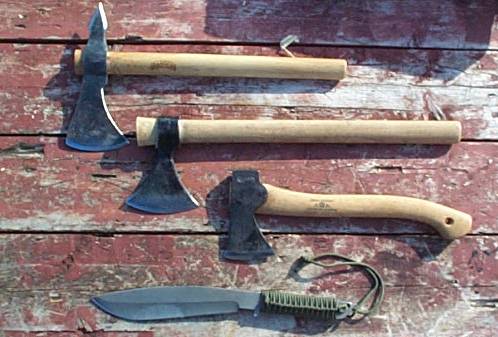
The Norse Tomahawk has a four inch blade with a hickory handle and an overall length of 19". The head is drop forged from 5150, a medium carbon tool steel. It is differentially heat treated to unknown hardness levels. A shot of the tomahawk and several other blades :

From top to bottom; Rogers Rangers tomahawk from ATC, Norse tomahawk from Cold Steel, Wildlife Hatchet from Gransfors Bruks, and PAB from Strider.
Common utility axes have thick and obtuse edge bevels which can require a lot of work when new to form a decent shaped edge. The Norse tomahawk from Cold Steel is among the worse seen. The "edge" is up to half a millimeter of steel thick at places as the bevels do not even meet. The extreme bluntness makes precision cutting impossible, even chopping is difficult as the tomahawk tends to just mash wood. However the steel is decently soft, easily worked with a file, so the edge was formed in a few minutes with a large bastard file. With the edge sharpened (but still very thick and obtuse) it was compared to the Wildlife Hatchet from Gransfors Bruks. The Tomahawk was readily outperformed in all aspects, cutting, chopping and splitting ability, control, and handle security and ergonomics.
A file was tried at first to cut down the edge, but since a lot of metal had had to be removed work was done with a belt sander. The edge was then sharpened on some sandpaper and the performance was now decent on slicing rope, fabrics, meats, and whittling and chopping wood. It was still readily outperformed by the Wildlife Hatchet however it could out chop the Trailmaster from Cold Steel on large wood. But on smaller wood such as limbing and general brush work, the tomahawk fell behind rapidly.
The Wildlife hatchet has the traditional hardwood axe grind which is a convex to hollow to convex profile. The hollow relief gives maximum penetration with minimal wedging. The Norse tomahawk however is basically the same thickness until it swells up for the eye. The lack of any taper or relief means that the tomahawk will bind readily on woods in which the hatchet is very fluid. The hatchet is then a much more efficient tool. The binding effect is also evident in splitting as the tomahawk gets stuck fast in small rounds that the Wildlife hatchet can easily split. The hatchet also has a handle that is much more secure and ergonomic. However the tomahawks handle is much easier to throw, and replace if broken.
After a few minutes to sort out the rotation it wasn't difficult to get constant hits for one rotation throws at a distance of about 15 feet. However the eye does not have enough of a taper to hold the head securely so it was constantly coming off. The handle took many impacts before it broke (a thousand throws) and was then easily fixed by filling the split with epoxy and clamping the handle until it dried. The edge also held up very well after main dirt impacts. It is very hard and resists denting very well and at the same time showed no sign of being brittle.
For general utility this isn't a great choice because of the poorly formed edge which is also thick and obtuse. There is also a lack of taper to the eye, no relief grind to the bit, and a not overly secure or ergonomic handle. However the head was found to be very durable and does make a decent tomahawk to practice throwing.
UPDATE : this tomahawk is still in one piece two years later and still gets thrown on a semi-regular basis and takes a lot of hard head impacts including off of rocks with no evidence of significant brittle failure.
Comments can be sent to : cliffstamp[REMOVE]@cutleryscience.com.
| Last updated : | Thu Apr 17 13:49:27 NDT 2003 |
| Origionally written : | Thu Mar 1 13:39:38 NST 2001 |